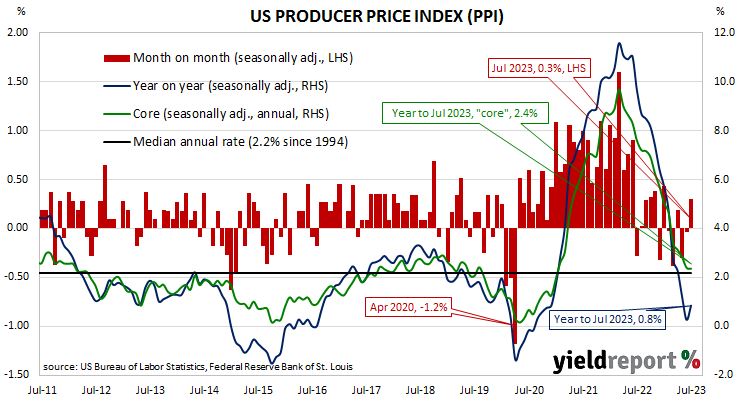Summary: US producer price index (PPI) up 0.3% in July, more than expected; annual rate increases to 0.8%; “core” PPI up 0.3%; NAB: highlights sensitivity to reacceleration risk; Treasury yields rise, especially at short end; 2024 rate-cut expectations soften; services prices up 0.5%, goods prices up 0.1%.
Around the end of 2018, the annual inflation rate of the US producer price index (PPI) began a downtrend which continued through 2019. Months in which producer prices increased suggested the trend may have been coming to an end, only for it to continue, culminating in a plunge in April 2020. Figures returned to “normal” towards the end of that year but were well above the long-term average through 2021, 2022 and the first quarter of 2023.
The latest figures published by the Bureau of Labor Statistics indicate producer prices increased by 0.3% after seasonal adjustments in July. The result was more than the 0.2% rise which had been generally expected as well as June’s flat result after it was revised from 0.1%. On a 12-month basis, the rate of producer price inflation after seasonal adjustments and revisions accelerated from 0.3% in June to 0.8%.
Producer prices excluding foods and energy, or “core” PPI, also increased by 0.3% after seasonal adjustments. The result was also greater than expected 0.2% increase and in contrast with June’s 0.1% decline. The annual rate remained steady at 2.4%.
“A downward revision to the previous month also didn’t flatter the July outcome,” said NAB economist Taylor Nugent. “Nonetheless, with the market increasingly confident of a soft landing, the upside surprise does highlight sensitivity to the risk of reacceleration so long as labour markets remain tight and demand remains resilient.”
US Treasury bond yields rose on the day, especially at the short end. By the close of business, the 2-year Treasury yield had gained 6bps to 4.89%, the 10-year yield had added 4bps to 4.15% while the 30-year yield finished 1bp higher at 4.26%.
In terms of US Fed policy, expectations of a lower federal funds rate in the first half of 2024 softened. At the close of business, contracts implied the effective federal funds rate would average 5.34% in September, slightly above the current spot rate, and then increase to an average of 5.355% in October. December futures contracts implied a 5.41% average effective federal funds rate while August 2024 contracts implied 4.695%, 64bps less than the current rate.
The BLS stated a 0.5% rise in final demand services led the overall gain. Prices of final demand goods increased by 0.1%.
The producer price index is a measure of prices received by producers for domestically produced goods, services and construction. It is put together in a fashion similar to the consumer price index (CPI) except it measures prices received from the producer’s perspective rather than from the perspective of a retailer or a consumer. It is another one of the various measures of inflation tracked by the US Fed, along with core personal consumption expenditure (PCE) price data.


